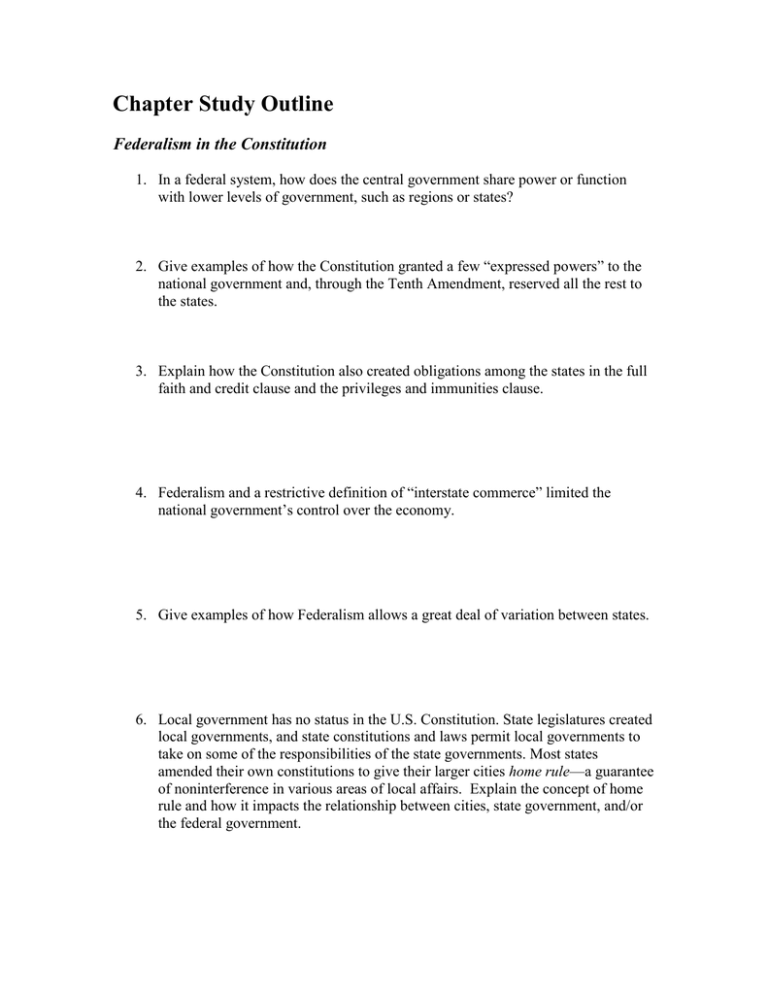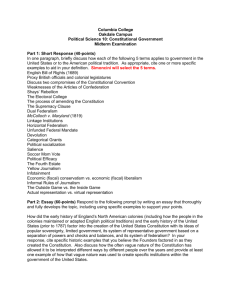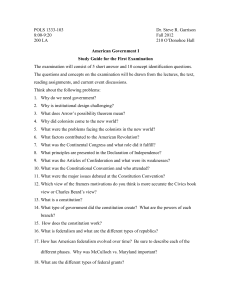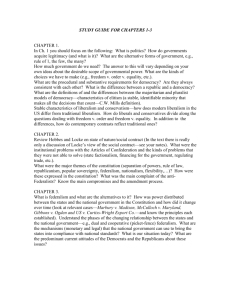Chapter Study Outline Federalism in the Constitution
advertisement

Chapter Study Outline Federalism in the Constitution 1. In a federal system, how does the central government share power or function with lower levels of government, such as regions or states? 2. Give examples of how the Constitution granted a few “expressed powers” to the national government and, through the Tenth Amendment, reserved all the rest to the states. 3. Explain how the Constitution also created obligations among the states in the full faith and credit clause and the privileges and immunities clause. 4. Federalism and a restrictive definition of “interstate commerce” limited the national government’s control over the economy. 5. Give examples of how Federalism allows a great deal of variation between states. 6. Local government has no status in the U.S. Constitution. State legislatures created local governments, and state constitutions and laws permit local governments to take on some of the responsibilities of the state governments. Most states amended their own constitutions to give their larger cities home rule—a guarantee of noninterference in various areas of local affairs. Explain the concept of home rule and how it impacts the relationship between cities, state government, and/or the federal government. 7. The rise of national government activity after the New Deal did not necessarily mean that states lost power directly. How did states retain their power even with the increased size of the federal government? The Changing Relationship between the Federal Government and the States 1. Explain the traditional system of federalism. What was the scope/size of the federal government? What was the primary aim of the government? 2. Under the traditional system, who does the majority of the “ruling/governing”? . 3. How did the system of federalism limit the expansion of the national government despite economic forces and expansive interpretations of the Constitution in cases such as McCulloch v. Maryland and Gibbons v. Ogden? 4. For most of U.S. history, the concept of interstate commerce kept the national government from regulating the economy. But in 1937, the Supreme Court converted the commerce clause from a source of limitations to a source of power for the national government. Give examples of the expansion of national power during the Great Depression. 5. Recent years have seen a revival of interest in returning more power to the states through devolution. As states have become more capable of administering largescale programs, the idea of devolution has become popular. Explain the idea of devolution. How has the federal government returned power to the states? Who Does What? Public Spending and the Federal Framework 1. Some federal programs bypass the states by sending money directly to local governments or local organizations. The states are most important, however; they are integral to federal programs such as Medicaid. 2. How does the national government impose regulations on states and localities in areas? What are some of the problems created by national standards? 3. Under President Richard Nixon, many categorical grants were combined into larger block. How did the block grants give more power to the states? How did revenue-sharing transfer power back to the states? 4. Politicians from both parties regularly turn to the federal government to override decisions made by states. Likewise, when the federal government proves unable or unwilling to act, advocates and politicians try to achieve their goals in states and localities. In many cases, it is up to the courts to decide which level of government should have the final say. What are examples of where the courts have decided whether the federal government or states have control to achieve their goals? Thinking Critically about the Federal System 1. Some of the sharpest tensions among liberty, equality, and democracy are visible in debates over federalism. What are the arguments for expanded power the federal government? What are the arguments for expanded power of the states? 2. The Constitution limited the power of the national government to safeguard liberty, but over the course of American history, a strong national government has been an important guarantor of liberty. Give examples throughout U.S. History where the national government has passed laws to guarantee liberty. 3. A key puzzle of federalism is deciding when differences across states represent the proper democratic decisions of the states and when such differences represent inequalities that should not be tolerated. What are at least TWO examples where democratic decisions may have represented inequalities that should not be tolerated?








